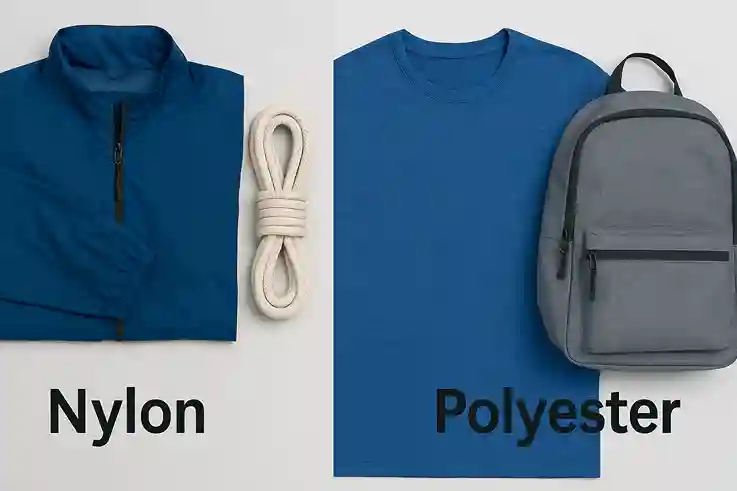Nylon vs Polyester is a common debate in fabrics. Both materials appear in clothing, gear, and even furniture. People often ask which one is stronger. Durability matters because sturdy fabrics last longer and protect better.
Still, the answer is not always simple. Each fabric offers benefits beyond durability. Nylon feels smooth and flexible. It absorbs some moisture, which can change comfort. Polyester, however, resists shrinking and stretching. It also dries quickly and keeps shape after many washes.
Cost becomes another factor. Polyester usually costs less, making it popular in everyday clothing. Nylon, however, often carries a higher price. The price difference links to fiber strength and long-term wear. Comfort also shapes choice. Nylon feels softer against skin, while polyester can feel warmer in hot weather. Use plays a role too. Outdoor gear often uses nylon for toughness. Everyday sportswear often uses polyester for light weight and fast drying.
This guide will stay clear and simple. You will see direct comparisons. Each section will highlight strengths and limits. By the end, you will understand how nylon vs polyester performs in daily life. Most important, you will know which fabric offers better durability for your needs.
What Makes Nylon Strong
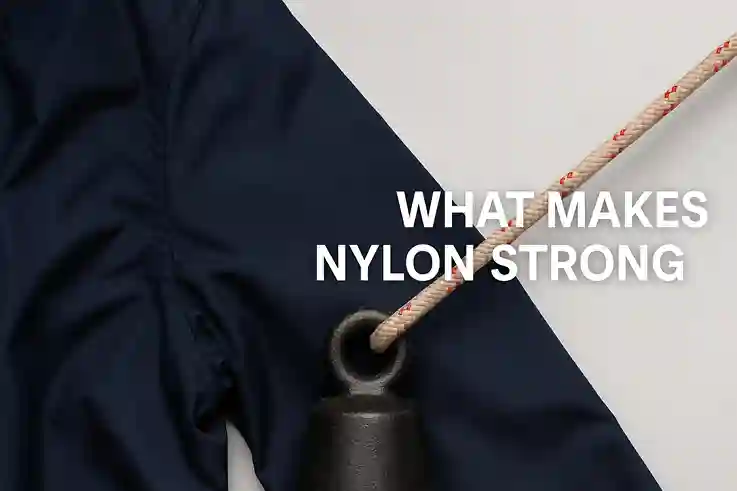
Nylon is one of the toughest synthetic fibers. Its structure uses tightly linked polymer chains. These chains give nylon high strength and resilience. The fiber does not break down easily under stress. This toughness makes nylon reliable in many uses.
One reason nylon performs well is its resistance to abrasion. Rubbing or scraping does little harm to the fibers. Backpacks, ropes, and outerwear often use nylon for this reason. The fabric can handle friction without wearing thin too quickly. That’s why it is common in products designed for heavy use.
Flexibility is another advantage. Nylon stretches without losing shape, which makes it useful in sportswear. Jackets, shorts, and active gear often rely on nylon for movement comfort. Outdoor gear also benefits because the fabric bends under pressure instead of tearing. Strong yet flexible, nylon balances both qualities in one material.
Because nylon absorbs moisture, it feels different from polyester. This single trait changes how the fabric performs in wet conditions. Nylon may feel heavier when soaked, while polyester stays drier. Still, for sheer toughness and abrasion resistance, nylon stands out.
How Polyester Holds Up
A Strong Synthetic Build
Polyester comes from synthetic polymers. The fibers form through chemical bonds that create strong, uniform chains. This structure gives the fabric a smooth and consistent feel. The build makes polyester tough under daily wear. It keeps strength even when pulled, stretched, or washed many times. Because of its stable form, polyester does not lose shape easily. The fabric feels firm and reliable in clothing and gear. As a result, polyester remains a trusted choice for long-lasting use.
Resistance to Shrinking and Stretching
One key advantage of polyester is its strong shape retention. The fibers resist shrinking even in hot water. They also hold firm against stretching during active wear. This stability makes polyester ideal for clothing that must keep its form. Sportswear, uniforms, and workwear all benefit from this trait. Home textiles like curtains and bedding also stay neat after many washes. Because the fabric needs less ironing and care, people choose it for convenience. As a result, polyester’s low maintenance appeal adds to its lasting popularity.
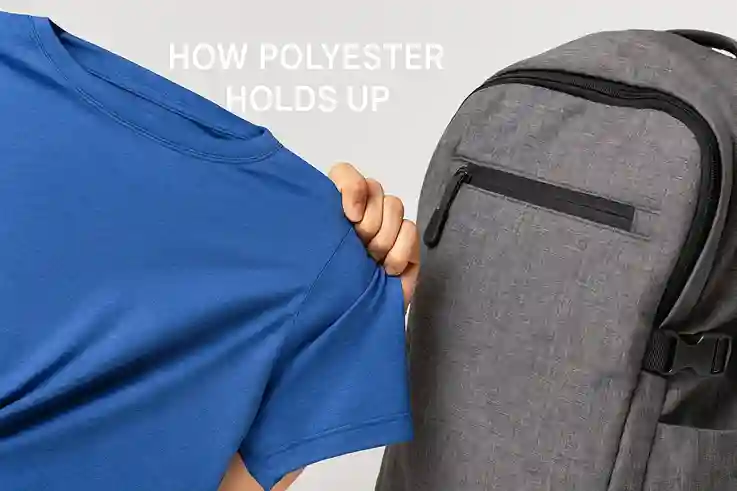
Quick-Drying Quality
Polyester does not hold moisture the way natural fibers do. Water stays on the surface instead of soaking deep into the fabric. Because of this, it evaporates fast. Clothes dry quickly, which helps during exercise, outdoor trips, or long travel days. This quick-dry quality also means less discomfort from sweat or damp weather. Another benefit is reduced odor buildup, since sweat does not linger in the fibers. For these reasons, many outdoor and fitness brands rely on polyester in their performance gear.
A Key Difference
Unlike nylon, polyester resists water better. The fibers naturally repel moisture and stay light even in damp weather. This water resistance makes polyester a smart choice for rain gear, jackets, and quick-dry apparel. It also reduces the heavy feeling that comes with soaked fabrics. Still, nylon provides advantages that polyester cannot match. Its flexibility and abrasion resistance give it an edge in rugged use. When compared together, both fabrics reveal unique strengths. Each serves a clear role depending on need and setting.
Nylon vs Polyester in Everyday Use
Clothing and Bags
Durability matters most in daily wear and gear. Nylon often lasts longer in bags, ropes, and luggage. The fibers resist scraping, tearing, and pulling with ease. This toughness makes nylon a reliable option for heavy-duty items. Polyester also performs well, but in a different way. It holds shape after repeated washing and daily use. That stability makes polyester ideal for uniforms, sportswear, and casual outfits. As a result, both fabrics stay strong in clothing and gear, but they serve slightly different needs.
Upholstery and Home Textiles
Polyester dominates in upholstery, curtains, and bedding. The fabric resists shrinking, stretching, and fading, even after frequent use. This stability makes it a low-maintenance choice for homes. People prefer polyester because it holds color well and keeps furniture looking fresh. Curtains and sofa covers stay neat with less effort. Nylon is less common in this space, but it does appear in select furniture coverings. When used, nylon offers added toughness. Still, polyester remains the more practical choice for home interiors.
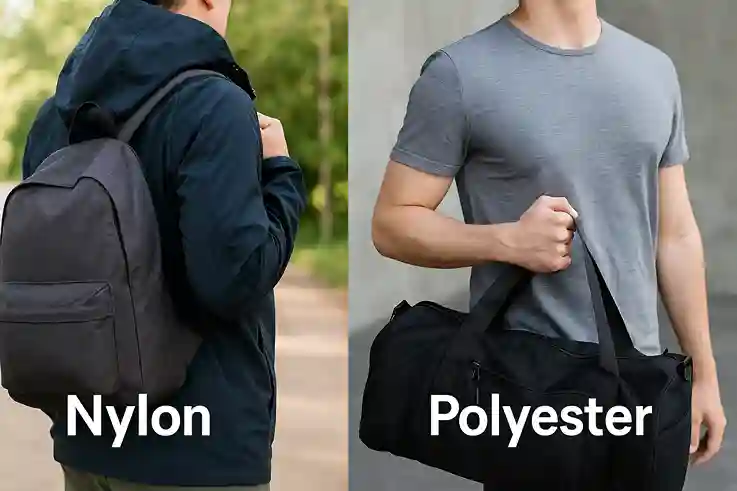
Outdoor Use
Nylon often wins in outdoor strength. Jackets, tents, ropes, and backpacks use nylon because it handles stress and rough terrain. The fibers resist abrasion and tearing when dragged over rocks or dirt. This toughness makes nylon a favorite for camping and hiking gear. Polyester also plays a role, mainly for its quick-drying nature. When it rains, polyester stays lighter than nylon. It resists water and dries fast, which adds comfort. Still, nylon holds greater strength under pulling and stretching in rugged settings.
Comfort and Feel
Nylon feels smooth and soft against the skin. The fibers bend easily, which adds flexibility during active movement. This quality makes nylon a popular choice in jackets, leggings, and activewear that require stretch. Polyester feels slightly warmer and less breathable in hot weather. The fabric can trap more heat, which may reduce comfort outdoors in summer. Still, its light weight makes it suitable for sportswear and travel clothing. Both fabrics provide comfort, though in different ways that depend on setting and activity.
So when choosing fabric, context matters. Each material delivers unique strengths based on use and setting.
Nylon vs Polyester in Everyday Use: Quick Comparison
| Feature | Nylon | Polyester |
|---|---|---|
| Durability | Stronger in bags, ropes, and luggage. Resists abrasion and heavy friction. | Holds shape in clothing. Strong under daily wear but less abrasion-resistant. |
| Clothing | Smooth, flexible, good for active movement. | Light, quick-dry, ideal for sportswear. |
| Upholstery | Rare, but tough in select coverings. | Common in curtains, bedding, upholstery. Keeps color and shape. |
| Outdoor Gear | Strong under stress. Used in jackets, tents, backpacks, ropes. | Quick-drying. Stays light in rain. Popular in outdoor clothing. |
| Comfort | Soft and smooth. More breathable. | Warmer in hot weather. Lightweight for sports and travel. |
Cost and Care Differences
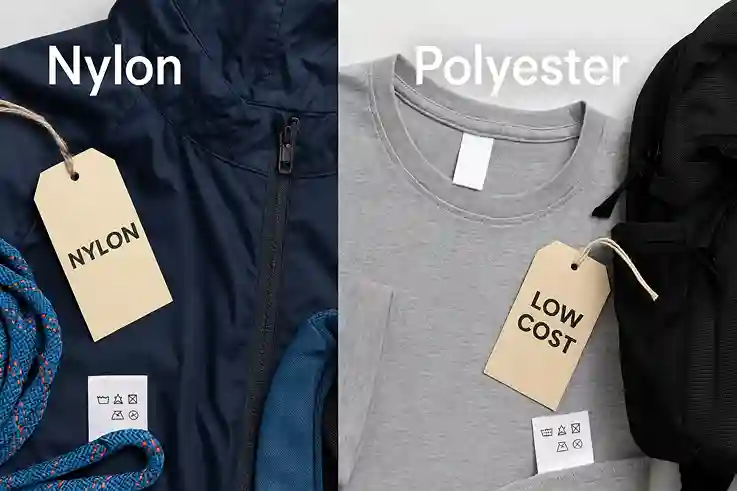
Price Range
Polyester usually costs less than nylon. The lower price makes it common in everyday clothing, sportswear, and home textiles. Many brands rely on polyester because it delivers strength at an affordable cost. Consumers also prefer it for budget-friendly options that last. Nylon often carries a higher price tag. Its toughness and flexibility raise production costs during manufacturing. The higher cost reflects the added performance value. For gear, luggage, and specialized wear, nylon’s price links directly to its superior durability and strength.
Washing and Long-Term Wear
Polyester requires less care in washing. The fibers resist shrinking and stretching, even in hot water. Clothes keep their original shape after many wash cycles. This low-maintenance quality adds value for busy lifestyles. Nylon is also durable, but it needs more attention. High heat from dryers or hot water can weaken its fibers. To extend life, nylon responds best to gentle washing and air drying. With proper care, both fabrics last, but polyester offers easier upkeep for everyday use.
Stain Resistance and Fading
Polyester resists stains and holds color well. Fabrics stay bright and vibrant even after repeated cleaning. This quality makes polyester a strong choice for uniforms, upholstery, and activewear that must look fresh. It also adds value in home textiles that face constant use. Nylon, however, can absorb oils and may stain more easily. Sunlight also affects nylon more, causing faster fading over time. Even so, the fiber itself stays strong. While colors may dull, nylon’s structure keeps its durability intact.
These care factors often shape the smarter choice. People who want low maintenance often lean toward polyester. Those who need higher toughness and strength may choose nylon, even with added care.
Nylon vs Polyester: Cost and Care Comparison
| Feature | Nylon | Polyester |
|---|---|---|
| Price Range | Higher cost. Toughness and flexibility increase production price. Common in gear, luggage, and performance wear. | Lower cost. Affordable for everyday clothing, sportswear, and home textiles. |
| Washing Needs | Needs gentle care. Avoid high heat. Best with cool washes and air drying. | Low maintenance. Resists shrinking and stretching. Keeps shape even in hot washes. |
| Long-Term Wear | Very durable with proper care. Strength lasts even with heavy use. | Consistent durability. Stays strong with little effort. |
| Stain Resistance | Absorbs oils. Stains more easily. | Resists stains. Cleans easily. |
| Fading Resistance | Fades faster in strong sunlight. Structure remains strong despite color loss. | Holds color well. Fabrics stay bright after repeated washes. |
Sustainability Factors
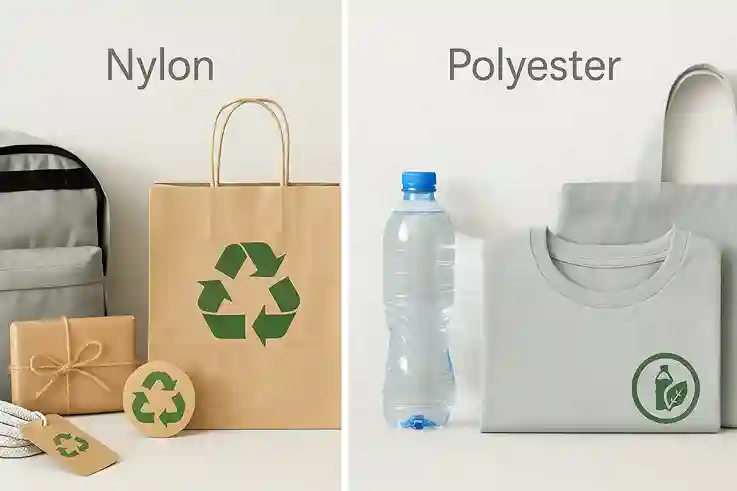
Environmental Impact
Both nylon vs polyester come from petroleum-based resources. As a result, their production creates carbon emissions and consumes significant energy. Nylon often requires more energy during manufacturing, which increases its environmental footprint compared to polyester. In addition, water use and chemical processing add to the impact. Polyester also carries a footprint; however, modern methods have improved efficiency. Some factories now reduce water waste and energy use during polyester production. Still, neither fabric is fully eco-friendly in raw form. Ultimately, their impact depends on longevity and whether recycling systems are applied.
Recycling Options
Recycling improves the sustainability picture for both nylon vs polyester. Polyester has the strongest recycling networks available today. For example, recycled PET bottles are often transformed into polyester fibers used in clothing and textiles. Many brands now rely on this process in sportswear, upholstery, and even accessories. Nylon can also be recycled; however, the process is more complex. Some companies reclaim nylon from fishing nets, carpets, and fabric scraps to create regenerated fibers. Still, both fabrics show real progress as recycling systems expand, scale up, and reach wider consumer markets.
Longevity and Value
Longevity plays a clear role in sustainability, and it also shapes the debate between nylon vs polyester. Durable fabrics reduce waste because they remain useful for many years. Nylon often lasts longer in heavy-duty products such as ropes, backpacks, and tents. Moreover, its abrasion resistance makes it ideal for rugged conditions. Polyester also performs well, especially in clothing, upholstery, and textiles that require strong shape stability. In addition, both fabrics prevent early replacement when cared for properly. This extended use lowers demand for new production and therefore reduces strain on resources.
Still, durability links back to lasting value. Choosing fabrics that endure extends both product life and resource efficiency. For most consumers, balance comes from selecting the fabric that fits the use while supporting recycled options when possible.
According to the U.S. Environmental Protection Agency, textiles like nylon and polyester make up a significant share of landfill waste, yet recycling rates remain low compared to their widespread use.
Nylon vs Polyester: Sustainability Comparison
| Feature | Nylon | Polyester |
|---|---|---|
| Environmental Impact | Higher energy use in production. Larger footprint from processing and water use. | Lower energy demand than nylon. Modern methods improve efficiency, but impact remains. |
| Recycling Options | Can be recycled, but process is complex. Often reclaimed from fishing nets, carpets, or fabric scraps. | Strong recycling systems. Commonly made from recycled PET bottles. Widely used in sportswear and textiles. |
| Longevity | Lasts longer in heavy-duty products like ropes, backpacks, and tents. Resists abrasion. | Long-lasting in clothing, upholstery, and items that need shape stability. Holds form after many washes. |
Fast Fashion and Fabric Use
Fast fashion makes the impact of nylon vs polyester even more important. Both fabrics are strong, yet fast fashion often reduces their potential. Clothes are made quickly and sold cheaply, which encourages frequent replacement. As a result, even durable fabrics like nylon and polyester end up in landfills sooner than necessary. Polyester dominates in fast fashion because it costs less and is easy to produce. Nylon appears less often but still adds to waste when used in disposable trends. Longer-lasting products reduce this cycle. Choosing recycled fabrics and avoiding fast fashion supports sustainability. Consumers who value durability can help shift demand away from short-term clothing and toward lasting use.
Adaptive Fashion and Fabric Choice
Adaptive fashion designs clothing for people with disabilities or limited mobility. In this space, fabric choice matters as much as design. The nylon vs polyester debate also plays a role here. Nylon offers flexibility and softness, which supports comfort in garments that need stretch and easy movement. Polyester, on the other hand, provides shape retention and quick-drying qualities. These features make clothes easier to care for and more practical for daily use. Both fabrics can support adaptive fashion, but balance depends on need.
“In the debate of nylon vs polyester, the smarter choice is not just about fabric, but about lasting value.”
FAQs on Nylon vs Polyester
Conclusion: Nylon vs Polyester
The debate of nylon vs polyester shows that both fabrics carry clear strengths. Nylon delivers toughness, flexibility, and abrasion resistance. It works best in outdoor gear, luggage, and heavy-duty items. Polyester, on the other hand, brings quick-drying ability, shape retention, and lower cost. It fits sportswear, uniforms, and home textiles.
Durability stays central to the choice. Nylon often lasts longer in rough conditions. Polyester, however, offers better performance in everyday clothing and environments where water resistance matters. Both fabrics have roles in sustainable use when recycling and longevity are considered. Avoiding fast fashion and choosing long-lasting products reduce waste for either option.
So when comparing nylon vs polyester, the smarter decision depends on context. Outdoor adventurers may prefer nylon for strength. Daily users may choose polyester for convenience. Both options provide value when matched with the right purpose.
What about your experience? Have you noticed differences in durability or comfort between nylon and polyester?
Share your thoughts, tips, or favorite uses in the comments. Your input can help others make better fabric choices.

Silvia Heart is a lifestyle and wellness writer with a background in apparel and a degree in fashion. She blends creativity with practical insights, guiding readers toward intentional, balanced living. Through her approachable style and thoughtful storytelling, Silvia inspires her community to embrace both everyday joy and personal growth.
